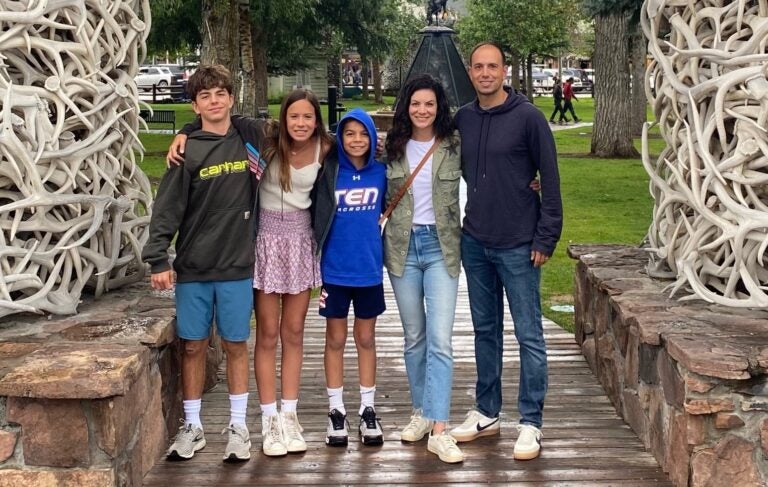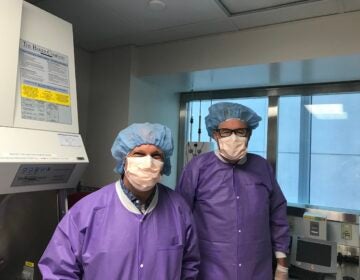No ‘playbook’: A Paoli teen is navigating a rare genetic condition. Her family says insurance is calling the shots
When it comes to rare diseases like HLH, the Zangrilli family says insurance can end up being the barrier to desperately needed treatment.
Listen 5:56
The Zangrilli family (left to right), August, Juliet, Henry, Molly and Gus, of Paoli, Pa. (Courtesy of Molly Zangrilli)
From Philly and the Pa. suburbs to South Jersey and Delaware, what would you like WHYY News to cover? Let us know!
Before she got sick, 13-year-old Juliet Zangrilli liked to spend time playing volleyball and lacrosse, hanging out with friends, going shopping and being at school, where she’s in the seventh grade.
Then everything changed this past February.
“I’ve been trying to do schoolwork, but it’s hard, because I’ve missed so much,” Juliet said. “I also have to take medicine in the morning and night.”
When Juliet fell ill, a roller coaster of fevers, high blood pressure and heart rate, a rash of small red dots and other symptoms initially mystified experts at the Children’s Hospital of Philadelphia.
A viral infection? Testing ruled out most types. Sepsis? Some of the symptoms fit, but not all. Cancer? There wasn’t enough evidence to support that, either.
Health providers at CHOP ordered genetic testing and eventually gave Juliet’s parents, Gus and Molly Zingrilli, a diagnosis: primary hemophagocytic lymphohistiocytosis, or HLH for short.
“I think for them, as providers, it was a little bit of closure. They certainly weren’t happy that this is what it was, but I think it finally answered all of these questions,” Molly said. “And I typically analyze lab results as a sport, but it was just too close to home. I couldn’t really read too much about HLH because it was too upsetting.”
Primary HLH is a rare genetic condition that causes white blood cells in the immune system to damage other healthy blood cells and organs. Most of the time, it is fatal without treatment.
A majority of diagnoses are caught early in infants and young children when symptoms typically appear. Juliet’s symptoms didn’t show until she was a teen. They didn’t follow a typical path, either, and required a unique treatment plan.
After a six-week hospital stay, and many ups and downs in Juliet’s health stats and labs, the CHOP team found a carefully calibrated combination of medications that worked to stabilize her.
“Her nightly fevers stopped, her high heart rate decreased and all of her inflammation markers came down precipitously,” Molly said. “It was like, oh my God, this is working. She can go home.”
Juliet did go home to Paoli, Pennsylvania, in late March. There, she would continue to take a concoction of medications to keep her stable and as healthy as possible as she awaited a bone marrow transplant, which could cure her condition.
“I’ve tried to explain this to my friends as un-confusing as possible,” Juliet said. “They understand and are really sad about it, but they’ve been supporting me and checking up on me.”
But the Zangrillis and CHOP’s care team ran into another problem: One of the primary medications that Juliet took to keep her stable included an oral drug called ruxolitinib. It’s FDA-approved to treat some blood cancers and graft-versus-host diseases in transplant recipients, but the drug is only in clinical trials to treat pediatric HLH.
That means when Juliet left the hospital and inpatient care, the family’s employer-sponsored health insurance plan with Blue Cross Blue Shield of Illinois denied outpatient coverage of the medication, which could cost more than $17,000 for a 60-count supply without insurance coverage, rebates or discounts.
Gus said this set the family up for another kind of fight: to get the insurers to change their decision.
“We spent full days on the phone, calling the number on the back of the card, talking to like, nine people who didn’t know who we were, still not hearing back,” he said.
This scenario is all too familiar to the health providers at CHOP, who see some of the most complex and rare pediatric diseases and illnesses in the country. Many cases rely on treatments and medications in clinical trials to find something that works well enough to send kids home.
“They [insurance] don’t really have a playbook for these kinds of ultra-rare disease situations,” said rheumatologist Dr. Scott Canna, who is treating Juliet at CHOP. “The knee-jerk response would be rejection because it’s not an FDA-approved indication.”
A ‘series of ridiculous conversations’
Therapy options for HLH are limited. Some types of treatments can require additional trips to the hospital, are usually delivered intravenously, and can involve chemotherapy drugs with short- and long-term health effects.
In Juliet’s case, CHOP specialists determined that ruxolitinib was the safest and most effective option for her. But the insurance company and the medical reviewers it appoints or contracts with disagreed.
“It seems insane,” Molly said. “As a parent, you just want to scream. How is this possibly happening? It just feels just so cruel.”
There’s little transparency around insurance approval and denial rates by individual plans. Companies are not required to report this data to public agencies or their policyholders, with some exceptions for public programs like Medicaid and Medicare.
A spokesperson at Blue Cross Blue Shield of Illinois, which is owned by its insurance policyholders instead of shareholders or investors, said in a statement that the company does not comment on individual claims or situations.
The company also stated, generally, that it provides administrative services for employers that design and fund their own health insurance plans for their staff — these are called self-funded plans — and “decisions to authorize or decline benefits are made based on the employer’s plan design.”
While the company did not disclose individual approval and denial data for its plans, national trade groups told ProPublica that “a substantial majority” of insurance claims and requests get approved, and some initially get denied due to errors or incomplete information from health providers. Some cases get reviewed by people with medical and nursing degrees, who are supposed to serve as professional peers to the health providers submitting the claims.
But Canna said that doesn’t seem to help with the rare and complicated diseases he sees.
“The level of sophistication that is necessary just to kind of understand what the disease is and what the state-of-the-art treatments are is so far beyond what an insurer’s authorization review process is capable of handling that it just falls through the cracks and becomes sort of a series of ridiculous conversations,” he said.
Bioethicist Art Caplan, a professor of medical ethics at NYU’s Grossman School of Medicine, said there is no good solution in sight for these cases that require unique treatment solutions.
“The system has not yet decided who’s going to pay for experimental, cutting-edge interventions that may or may not work, but are the best chance that some individual may have,” he said.
Having checks and balances across the system to keep costs low for everyone isn’t inherently a bad thing, Caplan said. But the current prior authorization process and the use of medical reviewers who are paid by the insurance companies creates several conflicts of interest.
“You are asking people who have the purse and the wallet and whose motivation for being there is to save the payer [insurer or employer] money, to assess the appropriateness of a treatment prescribed by an expert who knows the particulars about the patient,” Caplan said.
Meanwhile, CHOP nurse practitioner Hana Conlon said she is left feeling like she’s failed her patients every time she tells families that they can’t move forward with a test or treatment because of insurance denials.
“It’s like, everything within your power, all of the knowledge that you’re bringing to the table and all of your efforts to convince somebody that you know what you’re talking about, is being discredited,” Conlon said, “and you feel like you’ve let them down.”
Several states and legislatures are considering and passing laws focused on prior authorization reform. Some, like in New Jersey, aim to streamline the process for medical providers so that people can get approved for common treatments quickly. Others aim to ensure that only qualified physicians and health providers who specialize in certain areas of medicine or with specific therapies are appointed to conduct insurance medical reviews and make coverage decisions.
These are welcome changes, Canna said, but they will likely have little effect on health providers and patients like Juliet Zangrilli who are dealing with ultra-rare conditions with complex needs and few treatment options.
“It’s a long process,” Canna said. “I wish I could say that this is going to get better.”
‘There has to be awareness’
In the end, after weeks of going back and forth with the insurer and multiple denials, the Zangrillis and Gus’ employer worked out a short-term solution to cover Juliet’s outpatient medication.
It kept Juliet stable enough at home until she received a stem cell transplant on May 28 with a bone marrow donation from her younger brother, Henry. When she returns home from the hospital, she will spend about three months in isolation to prevent infection as her body works to rebuild a new immune system.
“There has to be awareness around how obstructive insurance companies are being in the care of sick kids and sick adults,” said Molly Zangrilli. “It just doesn’t seem fair for families that are going through something that is so terrible to make it worse for a reason that is really hard to understand.”
For 13-year-old Juliet, she’s just looking forward to a day when she can go back to school, see her friends and get back to life as it was before.

Get daily updates from WHYY News!
WHYY is your source for fact-based, in-depth journalism and information. As a nonprofit organization, we rely on financial support from readers like you. Please give today.






